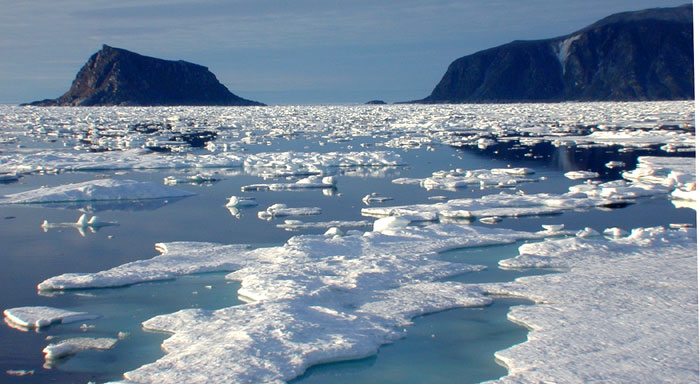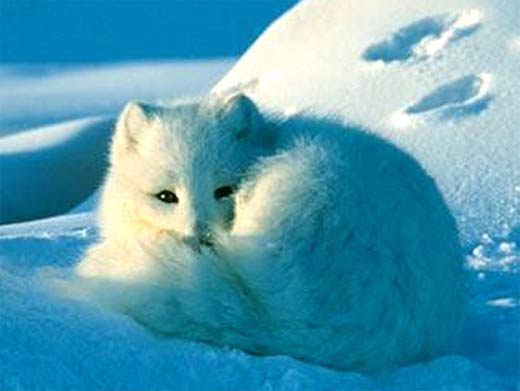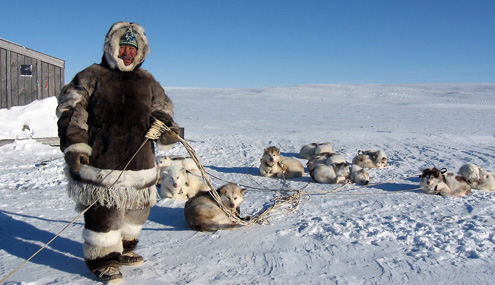I think over again my small adventures, my fears, these small ones that seemed so big. For all the vital things I had to get and to reach. And yet there is only one great thing, the only thing. To live to see the great day that dawns and the light that fills the world.
-- Inuit Song
The Arctic is a callous terrain, with bitterly freezing temperatures, few inhabitant creatures, little precipitation, while vast expanses of icy snow and tundra covered over the region. Therefore, the residents of the Arctic must compromise with their dominating environment in order to survive. Without forests, mud, nor clay, or any way to cut through the glaciers and retrieve rocks for the construction of shelter. The Inuit people must depend on a far abundant resource, and that would be the ice, in addition to snow of their glacial surroundings. An itinerant life trailing after prey must depend on simplistic, adequate built homes.
In winter, Inuit people constructed a circular dome shaped structure consisting of rectangular blocks of ice and snow placed level upon level in a spiral like shape. These were called “Igloos”, and the reason they were created so commonly among the Inuit nation was due to several important reasons:
a) No other resource in the northern Arctic was as plentiful as ice & snow all year around.
b) Other building materials were rare, with diminutive amounts, or perhaps fragile and could be easily corroded.
c) Inuit people were constantly travelling in search of new hunting grounds.
In the short, cool summers, animal hide tents were made since in the summers the native families would travel to hunt caribou, gather barriers, and catch fish. The tenets were made from seal or whale skins both which was waterproof to precipitation, the hide tents were also easy to setup or taken down in a moments notice. Many were well insulated from the frigid weather of the Arctic.
Food:
Food:
Food provisions were obviously scarce in the bitter lands of the North. Inuit people who lived inland, hunted on caribou, foxes, and musk ox typically in the fall. While in the coastal regions of the Arctic, families had diets composed of sea animals such as seal, walrus, whales, as well as fish. Vegetation was extremely limited in the North, due to this an Inuit’s main food source was meat, all sections of the animal was used for survival, including fat. Animal fat was gathered, and then rendered into oil used in soapstone lamps used for light and heat.
Cooking was a tedious process in which most Inuit tend to ignore, however at time when meat was to be cooked the Inuits used bow-drills, driftwoods, and dried mosses to initiate a fire for cooking, still most fresh meat from prey was eaten raw or just slightly warmed. “Ulus” was the common feasting utensil for these natives. Foods, such as berries, fish, and seaweed were preserved to last through the winter. While the meat gathered in the winter from hunts were left outside the igloo to be kept frozen.
Cooking was a tedious process in which most Inuit tend to ignore, however at time when meat was to be cooked the Inuits used bow-drills, driftwoods, and dried mosses to initiate a fire for cooking, still most fresh meat from prey was eaten raw or just slightly warmed. “Ulus” was the common feasting utensil for these natives. Foods, such as berries, fish, and seaweed were preserved to last through the winter. While the meat gathered in the winter from hunts were left outside the igloo to be kept frozen.
Ever tried dog sledding before? The Northern Aboriginal people called the Inuit originally invented dog sledding for elongated travel upon the snow-ice encrusted, freezing territory of the Arctic. Dog sledding is where a pack of either huskies or wolf hounds teams together with the alpha (strongest beast) at the top of the row. Makeshift strings from the sled positioned at the rear were then clasped to the dogs.
Another way of traveling across the frozen land was by using snowshoes; a famous type of snowshoe invented by the Inuits was called “Athabasca snowshoes”. Either for hunting, or voyaging through water the Inuit invented the Kayaks, a slim boat made from sealskins or driftwood, and could only hold one person at a time. While Umiaks were open boats created to hold ten to twenty people, which were most used for immigration from one island to another.
Another way of traveling across the frozen land was by using snowshoes; a famous type of snowshoe invented by the Inuits was called “Athabasca snowshoes”. Either for hunting, or voyaging through water the Inuit invented the Kayaks, a slim boat made from sealskins or driftwood, and could only hold one person at a time. While Umiaks were open boats created to hold ten to twenty people, which were most used for immigration from one island to another.
The clothing of the Inuit were primarily manufactured from caribou skin, since the animal’s hair is hollow, thus trapping air forming a insulating affect. Usually pants and parkas were composed of several layers, within the inner layers animal hair faces inwards. Hoods sewn on the parkas had fur stitched onto the edges to trap the wearer’s breath thus warming their face. Boots as well as mittens were made from sealskin, caribou hide, sometimes stuffed with polar bear fur.
Various types of tools were by the Inuit people for hunting, transportation, games, and living essentials. A bow-drill was used for carving, cutting, and making fires for stoves. The ulu was used by Inuit women for skinning animals such as seals, caribous, and other types of prey. Harpoons were used to hunt for prey upon the Kayaks; it was a blade made from bone, iron, or stone with a fore shaft of either ivory or caribou antler. To fish, Inuits uses the Kakivak, spears were sued for fishing in shallow waters. Other common tools includes axes, different spears, knives, rope, bowls, plus many more diverse types of harpoons, some especially designed to pursue after whales.
Children of the Inuit enjoyed regular games such as tag, hide-and-seek, or pretending to hunt during the summer months. A type of toy called the ajagaak was played to sharpen a person's senses. It was constructed of a small pointed bone either sewn or attached to a larger thicker bone with a hole drilled in it, the game's objective was to swing the larger bone trying to use that motion to direct the bone needle through the hole in the center.
Due to long months that must be spend inside their dwellings, Inuit games consisted of both activities that involved mentally as well as physically. Some innovative pastimes includes the cat's cradle, a game in which the player entangle their fingers in string to create patterns that resemble animal shapes. Inuit people values group achievement more than self-achievement, in adult recreations such as fights, sparing, and arm throwing the winner was expected to be modest about their success not boasting.
Storytelling was another popular occupation for the Inuits, history, culture, learning was all passed along by stories told by the elders to their children. Commonly, stories revealed the close relationship that the natives had with their environment and nature, along with desirable personal traits like selflessness or truthfulness. Artistic carvings from the Inuit were usually resemblances of nature engraved upon stone; commonly serpentine was used due to its soft texture and varied colors. Other materials for carving could include caribou antlers, walrus tusks, as well as granite or marble. Beautiful carvings of polar bears, caribou, dogs, or whales were some of what the Inuit shaped with their plain tools. The environment shapes the artistic inspiration of the Inuits.
Due to long months that must be spend inside their dwellings, Inuit games consisted of both activities that involved mentally as well as physically. Some innovative pastimes includes the cat's cradle, a game in which the player entangle their fingers in string to create patterns that resemble animal shapes. Inuit people values group achievement more than self-achievement, in adult recreations such as fights, sparing, and arm throwing the winner was expected to be modest about their success not boasting.
Storytelling was another popular occupation for the Inuits, history, culture, learning was all passed along by stories told by the elders to their children. Commonly, stories revealed the close relationship that the natives had with their environment and nature, along with desirable personal traits like selflessness or truthfulness. Artistic carvings from the Inuit were usually resemblances of nature engraved upon stone; commonly serpentine was used due to its soft texture and varied colors. Other materials for carving could include caribou antlers, walrus tusks, as well as granite or marble. Beautiful carvings of polar bears, caribou, dogs, or whales were some of what the Inuit shaped with their plain tools. The environment shapes the artistic inspiration of the Inuits.
Inuit Video:

















